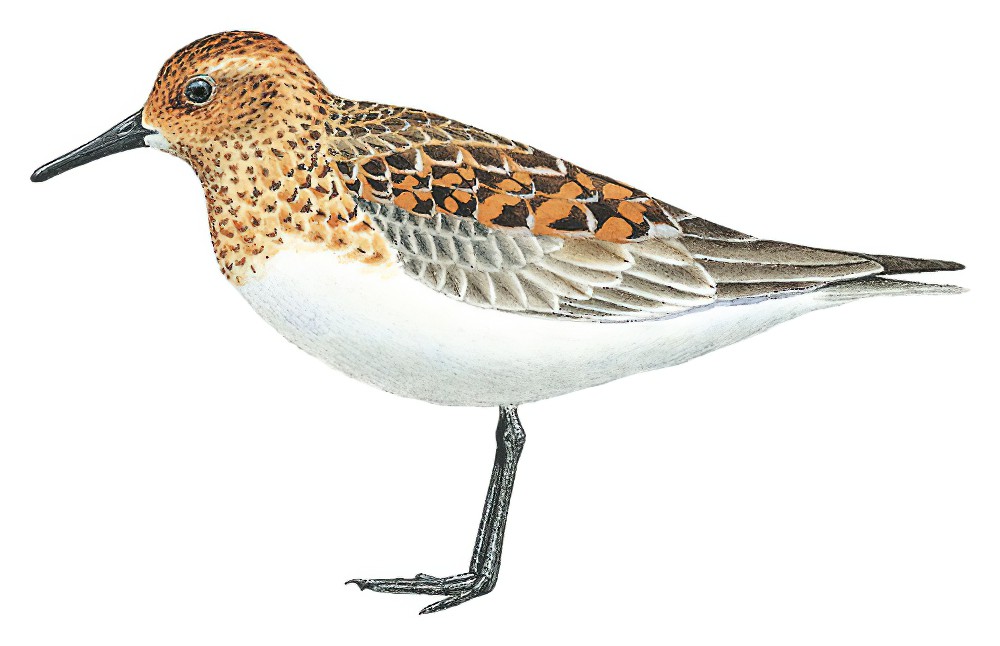Sanderling / Calidris alba

Sanderling
SCI Name:
Protonym: Trynga alba Cat.Ois.[Vroeg]Adumbr. p.7 no.320
Taxonomy: Charadriiformes / Scolopacidae / Calidris
Taxonomy Code: sander
Type Locality: Coast of the North Sea.
Author: Pallas
Publish Year: 1764
IUCN Status: Least Concern
DEFINITIONS
CALIDRIS
(Scolopacidae; † Red Knot C. canutus) Specific name Tringa calidris J. Gmelin, 1789 (= syn. Calidris canutus); "Knüffel, Calidris. Schnabel walzenförmig, gegen die Spitze hin dicker, glatt. Mittlere und äußere Zehe etwas verbunden. Tringa calidris, arenaria u.a." (Merrem 1804); "LES MAUBÈCHES. (CALIDRIS. Cuv.) (1) ... La grande Maubèche grise, Sandpiper et Canut, des Anglais. (Tringa grisea et Tr. Canutus. Gm.) Le plum. d'hiver, enl. 366. Edw. 276. ... (1) CALIDRIS, oiseau cendré et tacheté, fréquentant les rivières et les bois. Arist. Brisson l'applique à l'une des espèces de ce genre" (Cuvier 1817); "Calidris Anonymous = Merrem, Allg. Lit. Zeitung, 2, no. 168, 8 June, 1804, col. 542. Type, by tautonymy, Tringa calidris Gmelin = Tringa canutus Linné." (Peters, 1934, II, p. 280).
Var. Calidridris, Callidris, Callydris, Calydris, Chalidris.
Synon. Actia, Actodromas, Ancylocheilus, Anteliotringa, Aphriza, Arquatella, Canutus, Cinclus, Delopygia, Ereunetes, Erolia, Eurynorhynchus, Falcinellus, Hemipalama, Heteropoda, Heteropygia, Leimonites, Limicola, Limnocinclus, Machetes, Machophilus, Micropalama, Neopisobia, Pavia, Pavoncella, Pelidna, Philomachus, Pisobia, Platyrhamphus, Schoeniclus, Schoeniculus, Symphemia, Tryngites.
• (Scolopacidae; syn. Calidris † Sanderling C. alba) Specific name Charadrius calidris Linnaeus, 1766 (= syn. Calidris alba); "GENUS 89. CALIDRIS. Arenaria Meyer, Bechstein (Sandläufer Germ. Sanderling Angl.). Rostrum mediocre, tenue, rectum, teretiusculum, maxillae dertro paullulum incrassato, in apicem deflexo. Nares parvae, oblongo-ovales. Alae volatiles. Pedes grallarii, mediocres, cursorii, tridactyli, digitis ad basin usque fissis. Acropodia scutulata. Species: Charadrius Calidris Lin." (Illiger 1811); "Calidris ILLIGER, Prodromus, 1811, 249. Type, by [tautonymy and] monotypy, Charadrius calidris LINNÆUS = Tringa leucophæa PALLAS [= Trynga alba Pallas]." (AOU Check-List, ed. 3, 1910, 118); ""Tringa leucophaea" Anonymous (in Vroeg's Cat. Rais. d'Ois., p. 32, 1764—northern coast of Holland) is not binomial." (Hellmayr and Conover, 1948, Cat. Birds Americas, Pt. I (3), p. 171, footnote).
Synon. Arenaria, Arenula, Crocethia.
calidris
Gr. καλιδρις kalidris or σκαλιδρις skalidris speckled, grey-coloured waterside bird mentioned by Aristotle, not further identified, but later conjectured to be a sandpiper or a wagtail.
● ex "Petite Maubèche grise" of Brisson 1760 (syn. Calidris alba).
● "Der südliche Schlammläufer. Pelidna calidris, Br. (Tringa alpina, Linn.)" (Brehm 1831) (syn. Calidris alpina).
● ex “Rusticola sylvatica” of Gessner 1555, and Aldrovandus 1599-1603, and “Calidris” of Brisson 1760 (syn. Calidris canutus).
● ex “Totanus” of Belon 1555, and Brisson 1760, “Calidris Bellonii” of Aldrovandus 1599-1603, and “Gallinula erythropus major” of Willughby 1676, Ray 1713, and Marsigli 1726 (syn. Tringa totanus).
● ex “American Nightingale” of Edwards 1750 (unident.).
alba
L. albus white, dead white (cf. candidus glittering white) (see also albus).
● "76. ARDEA. ... alba. 17. A. capite lævi, corpore albo, rostro rubro. Ardea tota alba, capite lævi. Fn. svec. 132. Ardea alba major. Will. orn. 205. t. 43. Raj. av. 99. n. 4. Habitat in Europa." (Linnaeus 1758) (Ardea).
● ex “Cacatua” of Brisson 1760, and “Kakatoës des Moluques” of d’Aubenton 1765-1781, pl. 263 (Cacatua).
● ex “White Sheathbill” of Latham 1785, and “Vaginalis” or “Chionis” of Forster 1788 (Chionis).
● ex “Fedoa canadensis, rostro recurvo” of Edwards 1750, and “Limosa candida” of Brisson 1760 (?syn Limosa haemastica).
● "99. MOTACILLA. ... alba. 12. M. pectore nigro, rectricibus duabus lateralibus dimidiato oblique albis. Motacilla pectore nigro. Fn. svec. 214. Motacilla. Gesn. av. 618. Aldr. orn. l. 17. c. 23. Bell. av. 88. 6. Will. orn. 171. t. 42. Raj. av. 75. n. 1. Alb. av. 1. p. 49. t. 49. Frisch. av. . t. 23. f. 4. Olin. av. 43. Habitat in Europa." (Linnaeus 1758) (Motacilla).
● ex “Spatule blanche de L’Île de Luçon” of Sonnerat 1776. “Mr Ogilvie Grant argues for the adoption of Scopoli’s name of P. alba, founded on Sonnerat’s plate. Although the bird is said to have come from Luzon, it is well-known that many of Sonnerat’s species were obtained in Africa, and set down in error as being from the Philippines. That this has been the case with the present species hardly admits of a doubt” (Sharpe 1898) (Platalea).
● ex “Guira Panga” or “Cotinga Blanc” of de Buffon 1770-1783 (Procnias).
● ex “White-breasted Petrel” of Latham 1785 (Pterodroma).
● ex “Mouette cendrée tachetée” (= ☼) of d’Aubenton 1765-1781, pl. 387 (syn. Rissa tridactyla).
● ex “Gobe-mouche blanc huppé du Cap de Bonne Espérance” of d’Aubenton 1765-1781, pl. 234, fig. 2 (syn. Terpsiphone paradisi).
● ex “Curiçaca” of Marcgrave 1648, and “Courlis à col blanc de Cayenne” of d’Aubenton 1765-1781, pl. 976 (syn. Theristicus caudatus).
● ex “Aluco minor” of Aldrovandus 1603, “Common Barn-Owl”, “White-Owl” or “Church-Owl” of Ray 1676, and “Common Barn-Owl” or “White Owl” of Albin 1731 (Tyto).
UPPERCASE: current genus
Uppercase first letter: generic synonym
● and ● See: generic homonyms
lowercase: species and subspecies
●: early names, variants, mispellings
‡: extinct
†: type species
Gr.: ancient Greek
L.: Latin
<: derived from
syn: synonym of
/: separates historical and modern geographic names
ex: based on
TL: type locality
OD: original diagnosis (genus) or original description (species)












